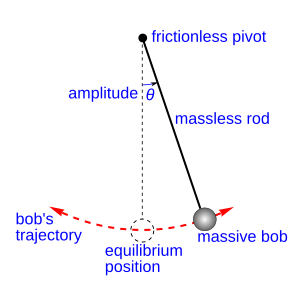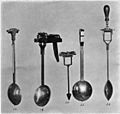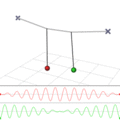Pendulum facts for kids
A pendulum is like a weight hanging from a string or rod that can swing freely. Imagine a ball tied to a string, held at the top, and then let go. It will swing back and forth! This swinging motion is called oscillation. Pendulums swing because of gravity, which pulls the weight downwards. If you push the weight to one side, it will keep swinging back and forth in a regular way.
The time it takes for a pendulum to complete one full swing (like going from one side, all the way to the other, and back again) is always the same. This time depends on how long the pendulum's arm or string is, and how strong gravity is in that place. It doesn't matter how heavy the swinging object is!
The regular movement of a pendulum makes it perfect for keeping time. That's why pendulums are used inside many clocks to help them tell time accurately.
How Pendulums Changed Clocks
In 1656, a Dutch scientist named Christiaan Huygens built the very first pendulum clock. This was a huge step forward for timekeeping! Before this, mechanical clocks weren't very accurate, often losing or gaining about 15 minutes a day. With Huygens' pendulum clock, accuracy improved a lot, to only about 15 seconds a day. Soon, pendulum clocks became popular all over Europe.
Around 1666, an English scientist named Robert Hooke studied a special type of pendulum called a conical pendulum. This pendulum could swing in a circle or an oval, not just back and forth. Hooke used this idea to understand how planets move around the Sun. He even suggested to Isaac Newton that the planets' movements were a mix of moving forward and being pulled towards the center. This idea helped Newton create his famous law of universal gravity. Hooke also thought that pendulums could be used to measure the strength of gravity itself.
Pendulums and Earth's Shape
In 1671, a French explorer named Jean Richer traveled to Cayenne, French Guiana. He noticed that his pendulum clock ran about two and a half minutes slower each day in Cayenne compared to Paris. From this, he figured out that the force of gravity was weaker in Cayenne.
Later, in 1687, Isaac Newton explained why this happened in his famous book, Principia Mathematica. He showed that the Earth isn't a perfect sphere. Instead, it's slightly flattened at the North and South Poles and bulges a bit at the equator. This is because of the centrifugal force created by the Earth spinning. Because of this shape, gravity is a little stronger near the poles and weaker near the equator.
After this discovery, people started taking portable pendulums on long voyages. These pendulums acted like super-accurate tools called gravimeters, helping scientists measure the strength of gravity at different places around the world. This research eventually helped us create very accurate models of the Earth's true shape.
-
A pendulum inside a tall grandfather clock.
Images for kids
-
A copy of an ancient Chinese seismometer (earthquake detector). It has a pendulum inside.
-
The Foucault pendulum in 1851 showed that the Earth spins without needing to look at stars. This animation shows its movement.
See also
 In Spanish: Péndulo para niños
In Spanish: Péndulo para niños













